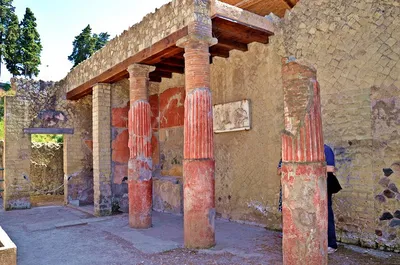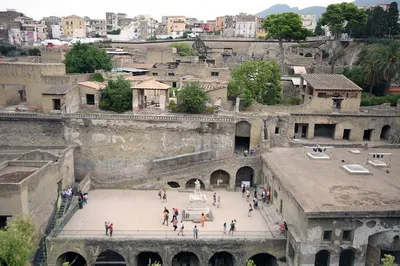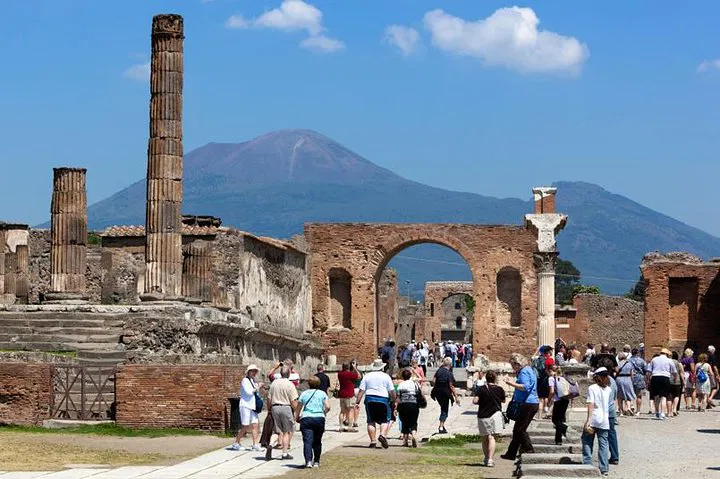Pompeii & Herculaneum: Archaeologist-Led Private Tour
420
Overview
Explore Pompeii and Herculaneum on a private tour led by an archaeologist. This full-day adventure takes visitors back in time to the ancient Roman cities tragically buried by Mount Vesuvius's eruption in 79 AD. Enjoy comfortable, private minivan transportation for a relaxed and immersive experience.
Herculaneum offers a remarkably preserved glimpse into Roman life. Though smaller than Pompeii, it boasts intact second stories, carbonized wooden objects, vibrant paintings, and detailed mosaics, showcasing the Altar of M. Nonius Balbus and the House of the Stags. Under the guidance of an expert archaeologist, the city's history comes alive, revealing the stories behind the House with the Opus Craticium and the Central Thermae. Then, discover Pompeii, a more expansive site where one can wander through streets like the Via dell'Abbondanza and feel the pulse of an ancient civilization. Key stops include the Pompeii Forum, the Pompeii Brothel (Lupanar), and the Stabian Baths.
What to Expect: This tour includes entrance fees ('Pompeii Express'), convenient hotel or port pickup and drop-off, private minivan transportation with a professional driver, and expert guidance throughout the day. The tour provides an in-depth look at well-known sites such as the Pompeii Granary, the Pompeii Basilica, and the House of Menander. Please note that meals and personal expenses are not included.




Highlights
Expert Archaeologist Guide: Explore Pompeii and Herculaneum with a knowledgeable archaeologist.
Private, Comfortable Transport: Relax with private minivan transport from your hotel or port.
Herculaneum's Well-Preserved Ruins: Discover intact buildings, mosaics, and artifacts in Herculaneum.
Extensive Exploration of Pompeii: Walk the streets of Pompeii and learn about daily Roman life.
Sentiment Analysis
Customers generally loved the personalized and informative experience, praising the guides and transportation. Some felt a bit rushed and wanted more independent exploration time.

Customers say the guides are very knowledgeable and passionate.
Many visitors loved that the private tour allowed them to customize the experience.
Reviewers appreciated the comfortable and convenient private transportation.
Guests really enjoyed the in-depth explanations of the ruins.
Some visitors felt rushed at certain sites.
A few reviewers wished for more free time to explore on their own.
The Journey
Herculaneum Ruins
Begin your journey at the Herculaneum Ruins, meeting your guide at the ticket office. Unlike Pompeii, Herculaneum was buried by a pyroclastic surge, preserving organic materials such as wood, fabrics, and even food. This provides a remarkably detailed snapshot of Roman life in the 1st century AD. Walk through the ancient streets and step back in time as you explore homes, shops, and public buildings, all incredibly preserved.
House of the Stags
Marvel at the House of the Stags, named for the exquisite marble statues of deer discovered in its peristyle garden. This opulent residence offers a glimpse into the luxurious lifestyle of Herculaneum's elite. Admire the intricate mosaics, well-preserved frescoes, and the stunning views of the sea from its terraces, picturing life in this beautiful home before the eruption.
Altar of M. Nonius Balbus
Visit the Altar of M. Nonius Balbus, a testament to the generosity of one of Herculaneum's most significant benefactors. M. Nonius Balbus restored and built many public buildings. His funeral altar displays a detailed inscription chronicling the honors bestowed upon him after his death. This site offers insight into the political and social structure of the city.
Building of the Augustales
Explore the Building of the Augustales, believed to have been a center for the cult of Emperor Augustus and possibly the headquarters of the Collegium Augustalium, or perhaps the local curia. This site provides valuable insights into Roman religious practices and the imperial cult. Examine the architectural details and imagine the rituals and ceremonies that once took place within these walls.
Central Thermae
Discover the Central Thermae, a well-preserved example of Roman bathing culture. Built in the 1st century AD, these baths were divided into separate sections for men and women, each with its own entrance. Explore the various rooms, including the frigidarium, tepidarium, and caldarium, and imagine the social and recreational activities that occurred here.
House with the Opus Craticium
Explore the House with the Opus Craticium, possibly owned by Marcus Nonius Balbus, featuring private access to the Suburban Thermae. This architectural curiosity showcases the innovative building techniques and luxurious lifestyles of Herculaneum's elite. Admire the unique construction, where timber and rubble create a sturdy yet lightweight structure, an early form of earthquake-resistant construction.
House of the Skeleton
Visit the House of the Skeleton, an aggregation of three smaller buildings named after the discovery of human remains in 1831. This somber find provides a poignant reminder of the eruption's devastating impact. Explore the layout of the house and reflect on the lives that were tragically cut short by the disaster.
House of the Black Hall
Step into the House of the Black Hall, one of Herculaneum's most luxurious mansions. The house features a monumental entrance with carbonized doorposts and lintel. This home gives you a sense of the opulence enjoyed by the city's wealthiest residents.
Wooden Partition House
Visit this important house to view the elegant wooden partition. This rare survival showcases the intricate craftsmanship and domestic arrangements of ancient Roman homes. Observe the details of the partition and appreciate its historical significance.
Samnite House
Explore the Samnite House, exhibiting a layout typical of the Samnites, an ancient people of central Italy. Admire the splendid atrium with Ionic columns and the rooms decorated with frescoes. This architectural gem offers a glimpse into the cultural influences that shaped Herculaneum.
House of the Wooden Screen
Discover the House of the Wooden Screen, one of Herculaneum's most original residences, featuring a courtyard with a stairway and a stone balcony instead of a traditional atrium. This unique design reflects the diverse architectural styles found in the city. Appreciate the innovative use of space and the glimpses of daily life it provides.
Domus at Herculaneum
Explore a beautiful domus in the center of the archaeological area, with various environments, collonnati, frescoes and charred remains of wooden parts. Experience the feeling of walking through a genuine Roman home. Appreciate the artistry and craftsmanship of the original inhabitants.
Pompeii Ruins
After lunch, continue your tour to the Pompeii Ruins, a vast and iconic archaeological site. Frozen in time by the eruption of Mount Vesuvius in 79 AD, Pompeii offers an unparalleled glimpse into Roman life. Walk along the ancient streets, explore remarkably preserved houses and shops, and marvel at the vibrant frescoes that once adorned the city's walls.
Pompeii Brothel (Lupanar)
Visit the Lupanar, Pompeii's most famous brothel, and gain a unique insight into the everyday lives of the lower classes in the city. See the erotic frescoes and carvings that adorned the walls of this establishment, and learn about the social context of prostitution in ancient Rome.
Pompeii Forum
Have a look at the ancient main square of Pompeii, where you can imagine the bustling activities of daily life. This was the heart of the city, where political, religious, and commercial activities took place. See the remains of temples, basilicas, and other public buildings that once surrounded the forum.
Pompeii Main Street (Via dell'Abbondanza)
Walk through the main street of Pompeii, the Via dell'Abbondanza. This bustling thoroughfare was the heart of the city's commercial activity, lined with shops, workshops, and homes. Imagine the sights, sounds, and smells of everyday life as you stroll along this ancient street.
Pompeii Granary
Explore the Granary in Pompeii, where you can view marble tables and baths for fountains that once adorned the entrances of houses. Also view the poignant casts of victims of the eruption, including a dog and a tree. These casts provide a powerful reminder of the human tragedy that unfolded here.
Pompeii Basilica
Visit the Basilica, an open portico that gave shelter to merchants and other activities. This served as a civic building, providing a space for legal proceedings, business transactions, and public gatherings. Imagine the lively atmosphere that once filled this grand structure.
Stabian Baths
Explore the Stabian Baths, the oldest thermal complex in Pompeii, located between the Brothel lane, the Holconius crossroads, and the Via Stabiana. These baths offer a fascinating glimpse into Roman bathing culture and social life. Explore the various rooms, including the changing rooms, hot and cold baths, and exercise areas.
House of Menander
Visit the House of Menander, one of the richest and most magnificent houses in ancient Pompeii. Admire the stunning architecture, intricate decorations, and valuable contents that have been unearthed here. This opulent residence provides a glimpse into the luxurious lifestyle of Pompeii's elite.
House of the Faun
Explore the House of the Faun, one of the largest and most impressive private residences in Pompeii. Admire its vast size, intricate mosaics, and impressive artwork. This grand house provides insight into the wealth and status of its former owners.
Pompeii Grand Theater
Visit the most important Theater in Pompeii, where you can imagine the dramatic performances and entertainment that once took place here. This large outdoor theater could accommodate thousands of spectators and was a central part of Pompeii's cultural life.
Pompeii Teatro Piccolo (Odeon)
Have a look at the so called Teatro Piccolo of Pompeii. This smaller, more intimate theater was likely used for musical performances, poetry readings, and other smaller-scale events. Appreciate the architectural details and imagine the cultural events that once took place here.
Know Before You Go
This tour includes an admission ticket ('Pompeii Express'), all entrance fees, hotel/port pickup and drop-off, private minivan transportation with a professional driver, and guidance throughout the entire tour. It excludes meals and personal expenses. Pick-up and drop-off are included from hotels or the port.
Hot Tip
Many reviewers suggest wearing comfortable shoes, as there will be a lot of walking on uneven ground. Bringing water and snacks is also a good idea, especially during the warmer months. The guide is very open to questions, so don't hesitate to ask!










